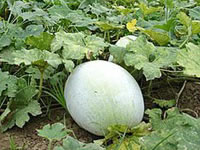Benincasa hispida
English: White Gourd
Sanskrit/Indian: Kushmanda
Russian: Восковая тыква

General information:
Ash Gourd is believed to have originated in Java, Indonesia. The Chinese have been cultivating it for over 2,000 years. Its medicinal uses first appeared in 659 AD in the Materia medica of the Tang dynasty. In Chinese medicine, the rind is used to treat urinary dysfunction and the seeds for vaginal discharge. The fruit is used to treat summer fevers.
In Ayurveda, the fruit is abeneficial for the management of a host of medical problems, including epilepsy, lung diseases, asthma, cough, urine retention and internal hemorrhage. It is also an excellent remedy for tapeworms.
Constituents:
Amino acids, mucins, mineral salts, starch and calcium are present in Ash Gourd. Phyto-chemical studies on the fruit indicated two triterpenes, alunsenol and mutiflorenol, which have cell stabilizing effects. The pulp of Ash Gourd is a rich source of vitamins B and C.
Benefits:
- Ash Gourd is ideal for diabetics and patients suffering from obesity.
- It combats general debility by stabilizing nerve cells.
- The cooling properties of its juice are helpful in treating peptic ulcers and for relieving acidity.
- Ash Gourd provides relief from constipation and tones the gastrointestinal tract.
- The seeds of Ash Gourd are anabolic and encourage tissue growth.
